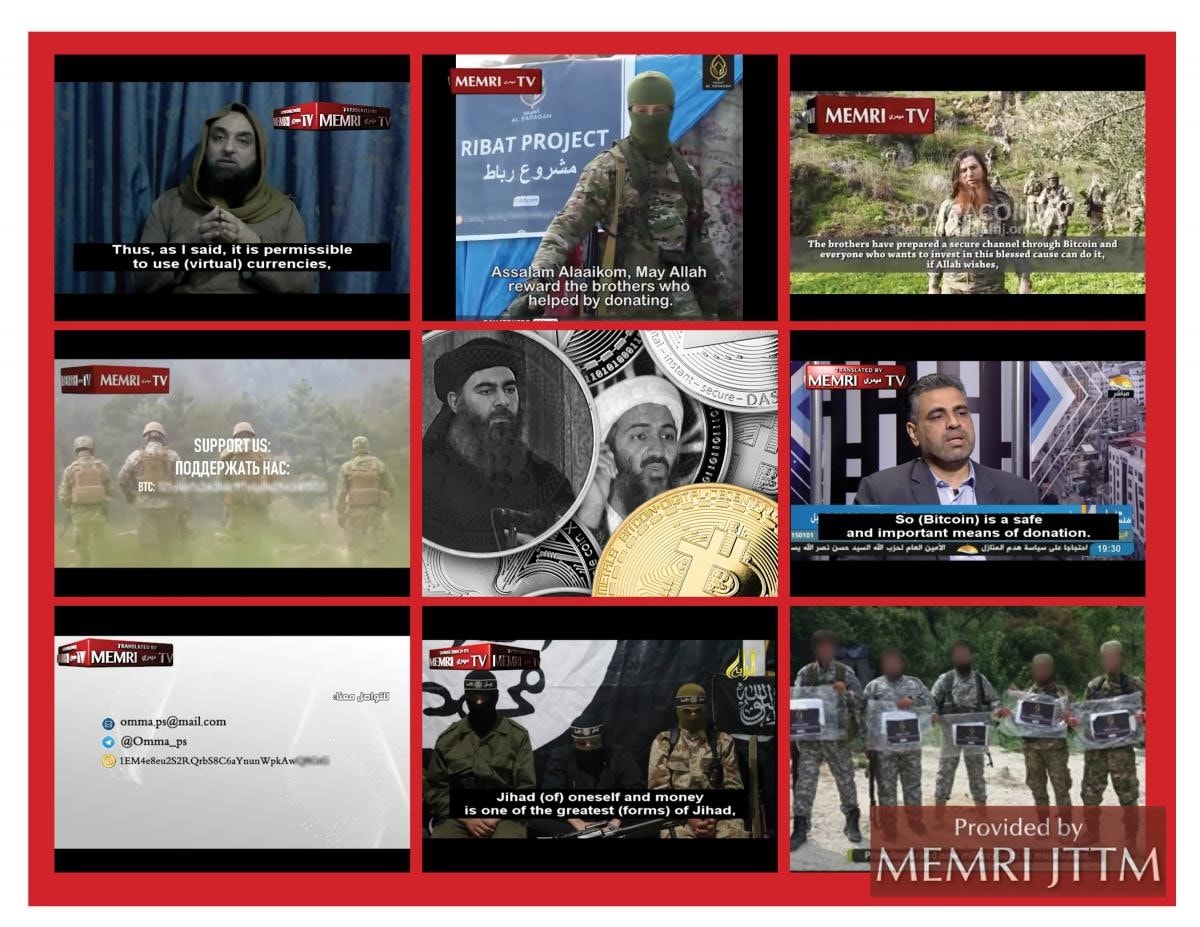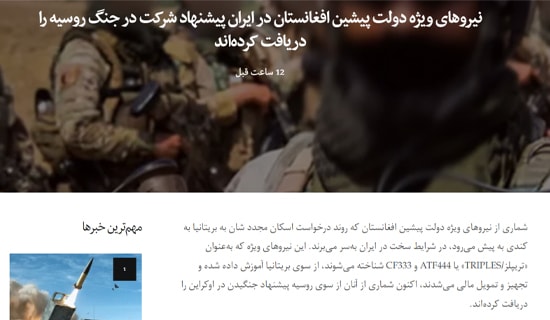The following are the preface and introduction of a new report released by the MEMRI Jihad and Terrorism Threat Monitor (JTTM). Currently it is only available to JTTM subscribers; however, credentialed members of media and government agencies may request a full copy at MEDIA@MEMRI.org.
Preface By Lt.-Gen. (ret.) Vincent R. Stewart, Former Deputy Commander Of The United States Cyber Command And Special Advisor And Chairman Of The MEMRI Board Of Advisors*
This study is the first significant research of its kind to show the scope of cryptocurrency use by terrorist organizations and their supporters, for fundraising and for financing attacks, purchasing equipment, supporting fighters and their families, and more. MEMRI research shows that over the past five years, this has developed from encouragement on jihadi blogs to donate "millions of dollars" in bitcoin to ISIS, Al-Qaeda, Hamas, the Muslim Brotherhood, and many others to terrorist groups and their supporters soliciting donations in various cryptocurrencies on social media.
The report documents cryptocurrency use by a wide range of terror entities on many different online platforms. MEMRI research has found that the main platform for terrorist fundraising today is the encrypted messaging app Telegram – terrorists' "app of choice." Terrorist groups regularly publish their bitcoin addresses when they solicit donations on online platforms –Telegram, Facebook, Twitter, and others – and also share detailed instructions via these platforms, in video, PDF, and other forms, to show potential donors how to donate in cryptocurrencies. This report reviews these, and also reviews the cryptocurrencies used by terrorists, which include, in addition to bitcoin, Dash, Ethereum, Monero, Verge, Zcash, and others.
MEMRI continues to be on the cutting edge of research on terrorist use of social media – notably on Telegram itself, and now with the looming threat of its imminent release of its TON blockchain and Gram cryptocurrency.
This landmark study shows undeniably that the future of terrorist funding and fundraising is happening now. The threat is too important to overlook; it must be researched and solutions must be arrived at, and this study is an important step in this direction. It will help educate those involved in the daily work of counterterrorism, and is a must-read for all those in government, the military, and academia who are concerned about this dangerous development.

* Lt.-Gen. (ret.) Vincent R. Stewart, former Deputy Commander of the United States Cyber Command, is Special Advisor and Chairman of the MEMRI Board of Advisors.
Introduction
As ISIS's Caliphate has crumbled, and as it and other jihadi and terrorist organizations increasingly depend on the Internet, the most significant and dangerous recent development in global terrorism is their embrace of cryptocurrencies to fund their activities. This has quietly become part of their cyber arsenal, and to date there has been a lack of understanding of how to stop it.
The blockchain and cryptocurrency industry continues to gain momentum, and more and more companies allow the use of cryptocurrencies and even launch their own, it is understood, and expected, that criminal elements, including terrorist groups, will move even more quickly than they are today to use them. In the early days of social media, companies, particularly Twitter, YouTube, and Google, waited too long to address terrorist usage of their services, and authorities were two steps behind as well. This should not happen again, but in order to prevent it, it is vital that these companies put in place – now – clear policies banning criminal cryptocurrency activity on their platforms, with repercussions and penalties for companies that do not do so.
Such companies include, for example, Facebook, which on June 18, 2019 unveiled its Libra cryptocurrency, set for launch next year, which is backed by Visa, Mastercard, PayPal Holdings, and Uber Technologies; Samsung, whose new Galaxy phone includes a cryptocurrency wallet; Apple, which recently revealed its new software release with a "cryptographic" tool; Amazon, where purchases with cryptocurrency will soon be possible; and Airbnb, where rentals with cryptocurrency already are.
Facebook's announcement of its cryptocurrency was greeted with near hysteria. U.S. media have labeled it a "terrible idea" "untethered in ambition," and "a bold, bad move" and House Financial Services Committee chairwoman Maxine Waters said Facebook was "continuing its unchecked expansion and extending its reach into the lives of its users" – and her call for hearings on Libra was backed by the senior-most Republican on the committee, Rep. Patrick McHenry. Internationally, Bank of England Governor Mark Carney said Libra must be "subject to the highest standards of regulation"; French Finance Minister Bruno Le Maire encouraged finance leaders from G7 countries to prepare a report on it for next month; and German European Parliament member Markus Ferber said that Facebook could become a "shadow bank" and that regulators should be on high alert.
While concern about the threat of cryptocurrency use by bad actors, especially terrorist groups, is absolutely warranted, the focus should be not on Facebook but on the encrypted messaging app Telegram, known for some time to be a favorite of terrorists and jihadis, including ISIS, and already being used for fundraising by terrorist groups. This threat is now growing exponentially, as the platform is about to launch its own blockchain, TON, and cryptocurrency, Gram, reportedly by October 2019. Counterterrorism officials need to be prepared for the coming explosion of terrorist use of Telegram's cryptocurrency.
Although cryptocurrency fundraising by these terrorist and jihadi groups and their supporters continues to increase, many who are attempting to do something about it, including in government circles and academia, have not yet developed the tools to tackle it. Furthermore, recent research that has been widely cited by media has concluded that there is little indication that terrorist organizations are even using cryptocurrency extensively or systematically, and have downplayed any threat.
However, this report, "The Coming Storm: Terrorists Using Cryptocurrency," which focuses on jihadis' growing use of cryptocurrencies and the threat that this poses, documents how these groups and individuals are already extensively fundraising in cryptocurrencies – including for attacks and for weapons and equipment purchases, for food and necessities for fighters' families, and more, as well as promoting their use and discussing how to use them on various online platforms. It shows MEMRI's monitoring of their growing sophistication over the years in using them, and their promotion of them as being easy, safe, and secure to use.
The report presents op-eds on these groups' use of cryptocurrency that were published in The Washington Post and The Hill by MEMRI Executive Director Steven Stalinsky, on the threat posed by Telegram.
As the research for this report was being carried out, MEMRI staff have been briefing U.S. and Western government agencies, media, academia, and legislatures about the ongoing findings. These efforts have also led to Congressional letters written with MEMRI's assistance, to Telegram CEO Pavel Durov insisting that he take immediate action against the well-known, well-documented widespread terrorist use of his platform by terrorists. The letters demanded, inter alia, that Durov "respond... with immediate urgency specifying a plan of action to combat extremist content on Telegram and create safeguards to prevent terrorist groups from using the platform as a secure fundraising tool."
This 250-plus page report comprises extensive and exclusive research, both published and not previously released, from the MEMRI Jihad and Terrorism Threat Monitor (JTTM) Project over the past two years. This research includes chatter by Western jihadis about using cryptocurrency, examines the use of cryptocurrency in fundraising campaigns and platforms, and also looks at how it is being promoted by jihadi and jihadi-linked organizations, tech groups, and individuals, from Al-Qaeda and the Islamic State (ISIS) to terrorist groups in the U.S. and the rest of the West as well as in the Middle East, Asia, and elsewhere.
Among the jihadi and terrorist groups examined in this report are pro-ISIS groups and the Al-Qaeda affiliate Hay'at Tahrir Al-Sham (HTS); the SadaqaCoins crowdfunding platform that links groups with donors using cryptocurrencies; the Al-Sadaqa organization which solicits donations in cryptocurrencies, and others. Hamas's military wing, the Izz Al-Din Al-Qassam Brigades, which is a U.S.-designated Foreign Terror Organization, is one of the terrorist groups most heavily promoting and using cryptocurrency, especially bitcoin, for fundraising, on platforms including Telegram, Twitter, and Instagram.
The report also includes discussions on online platforms and dissemination of tutorials on how and why to use cryptocurrency, as well as the sharing of bitcoin and other cryptocurrency addresses, including QR codes, for donating.
Many of these groups create dedicated social media accounts, on Telegram, Instagram, and other platforms, and hashtags for their campaigns, to disseminate attractive posters and graphics encouraging readers to donate, and listing prices of the equipment – ranging from uniforms to handguns to pickup trucks and RPGs – that their donations can buy. This report also details how prominent jihadi sheikhs, in the Middle East and the West, are promoting cryptocurrencies and depicting them as shari'a-compliant.
During the course of the research for this report, it was found that some groups, after receiving attention from media and authorities, apparently disappeared, along with their cryptocurrency wallets and addresses. This could have been because they were shut down by authorities, because they switched platforms and changed their social media accounts, or because they moved deeper into the Dark Web.
Accompanying this report is a short video compilation showing research from the report on jihadi groups and individuals actively involved in fundraising in cryptocurrency. To view the video, click here or below:
* Steven Stalinsky is Executive Director at MEMRI. Coauthored by: R. Sosnow, Lead Editor at MEMRI; M. Khayat, M. Al-Hadj, N. Mozes, A. Smith, R. Green, S. Benjamin, C. Caruso, E. Barret, and J. Goldberg, Research Fellows at MEMRI.
This report is available to JTTM subscribers; it will be published on MEMRI.org in the coming days. Members of media and government agencies may now request a full copy at MEDIA@MEMRI.org; you will be asked to provide your credentials.






